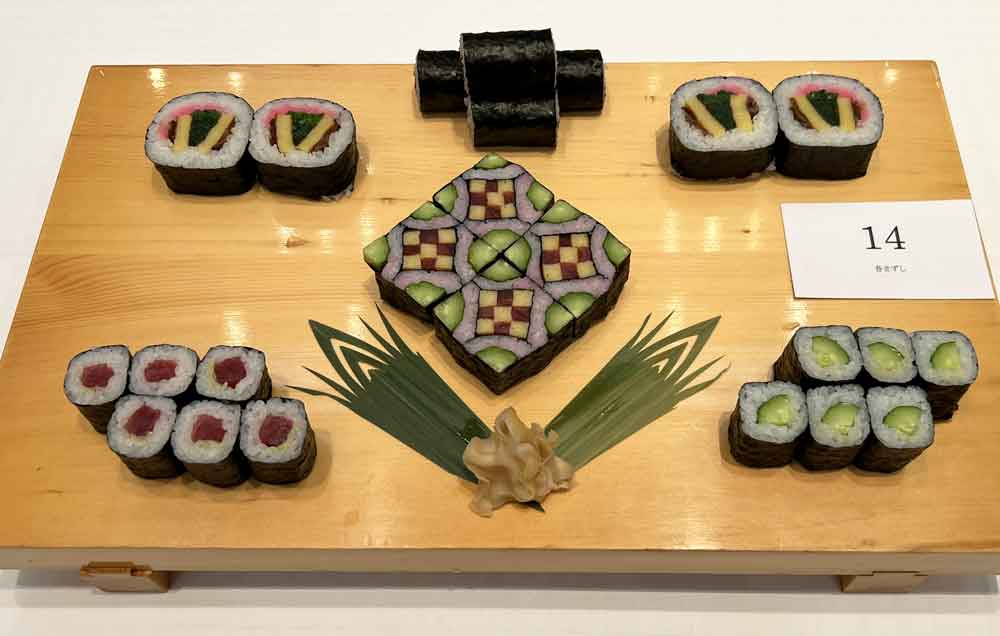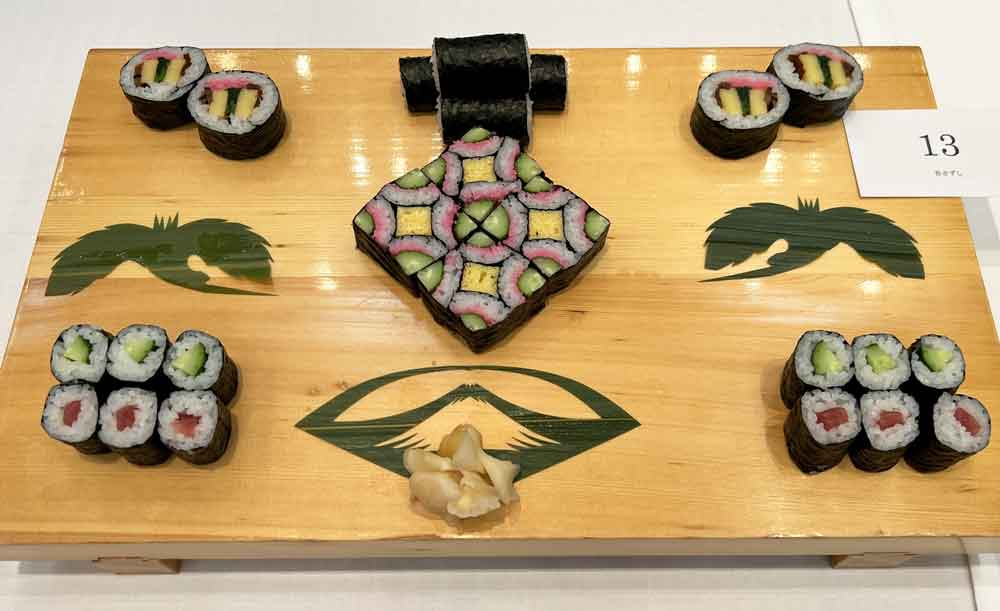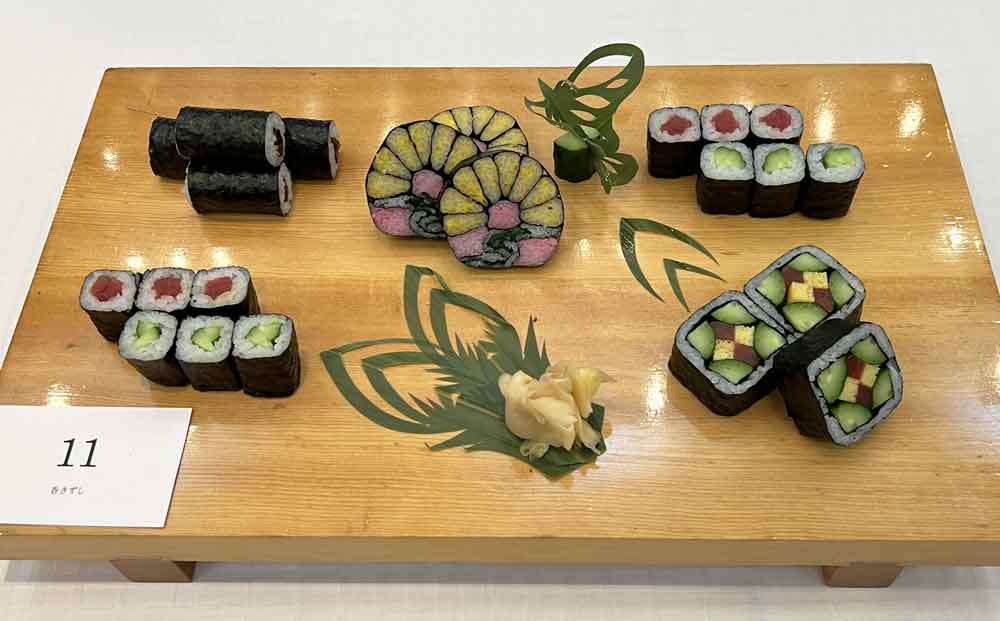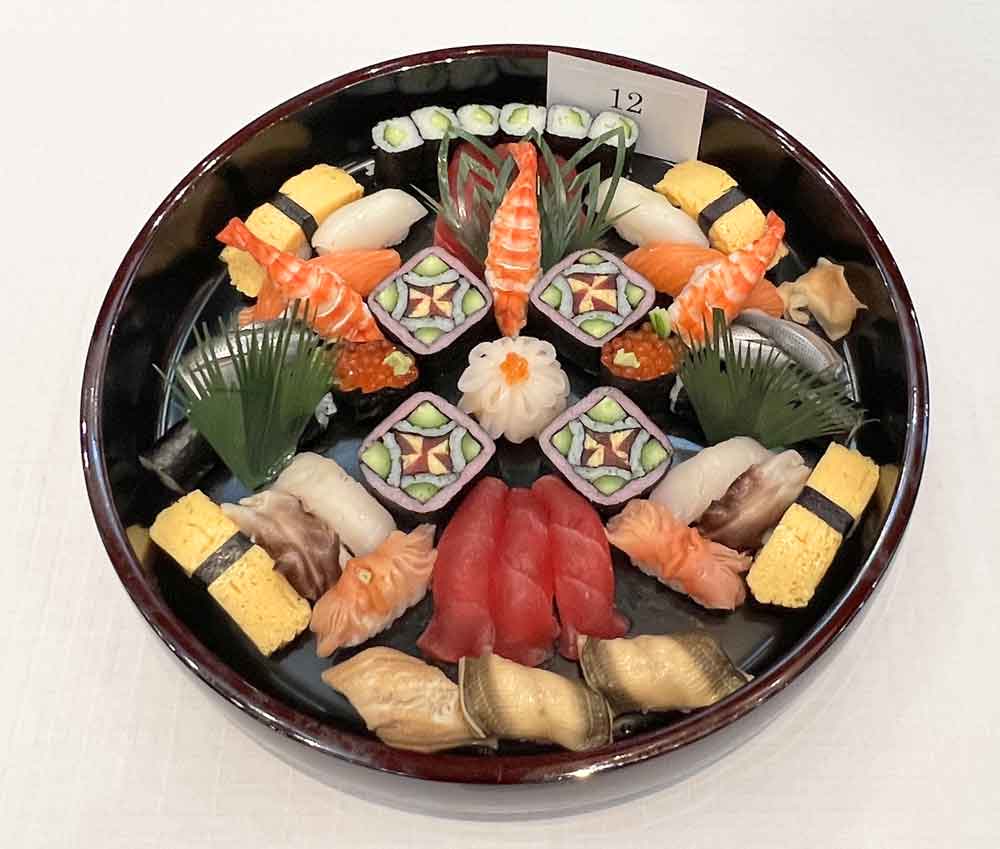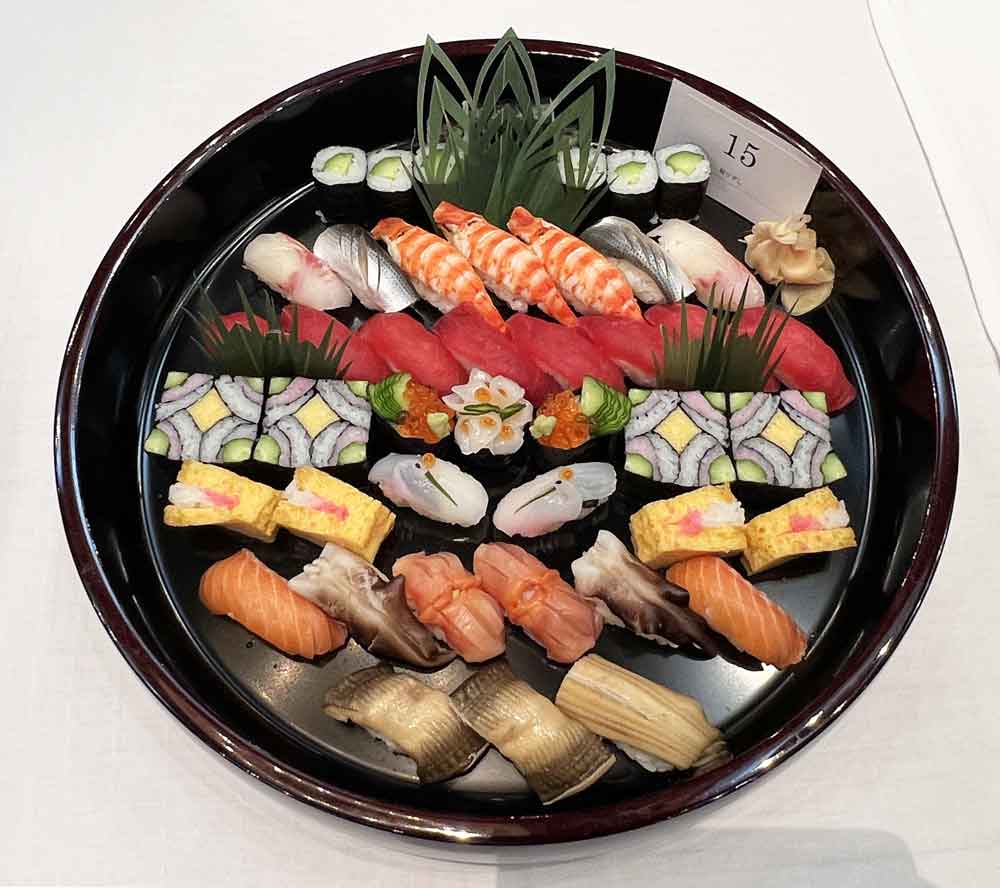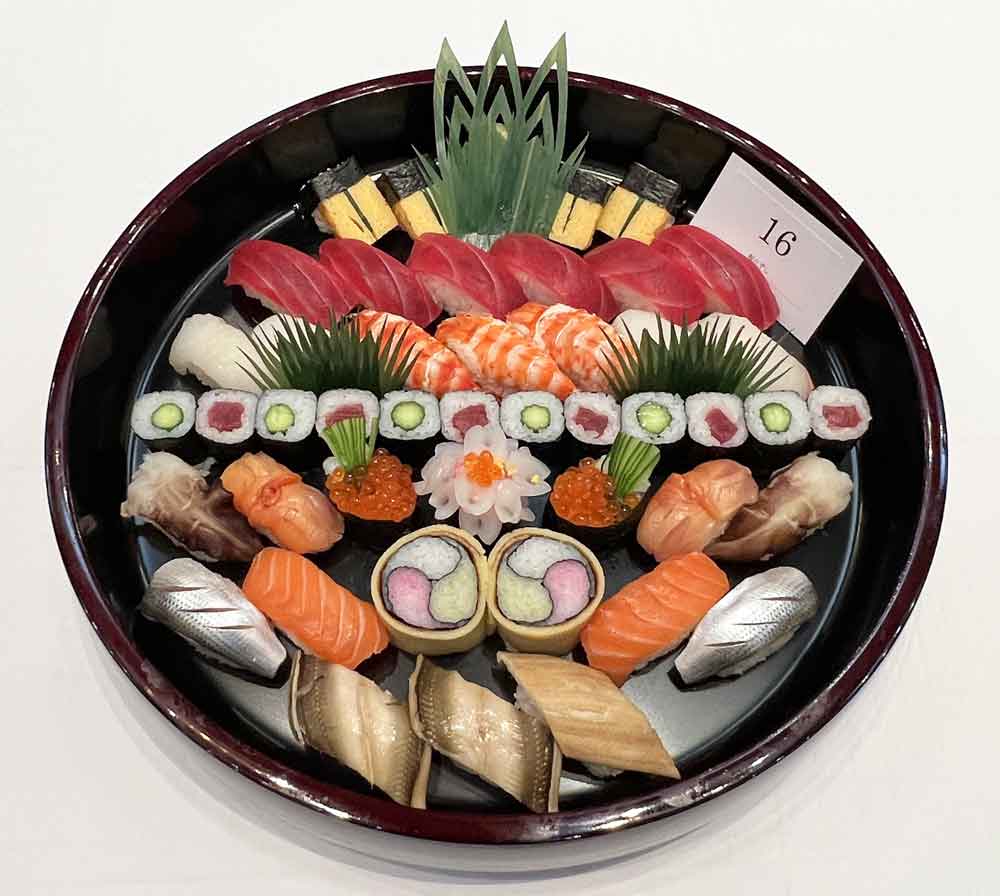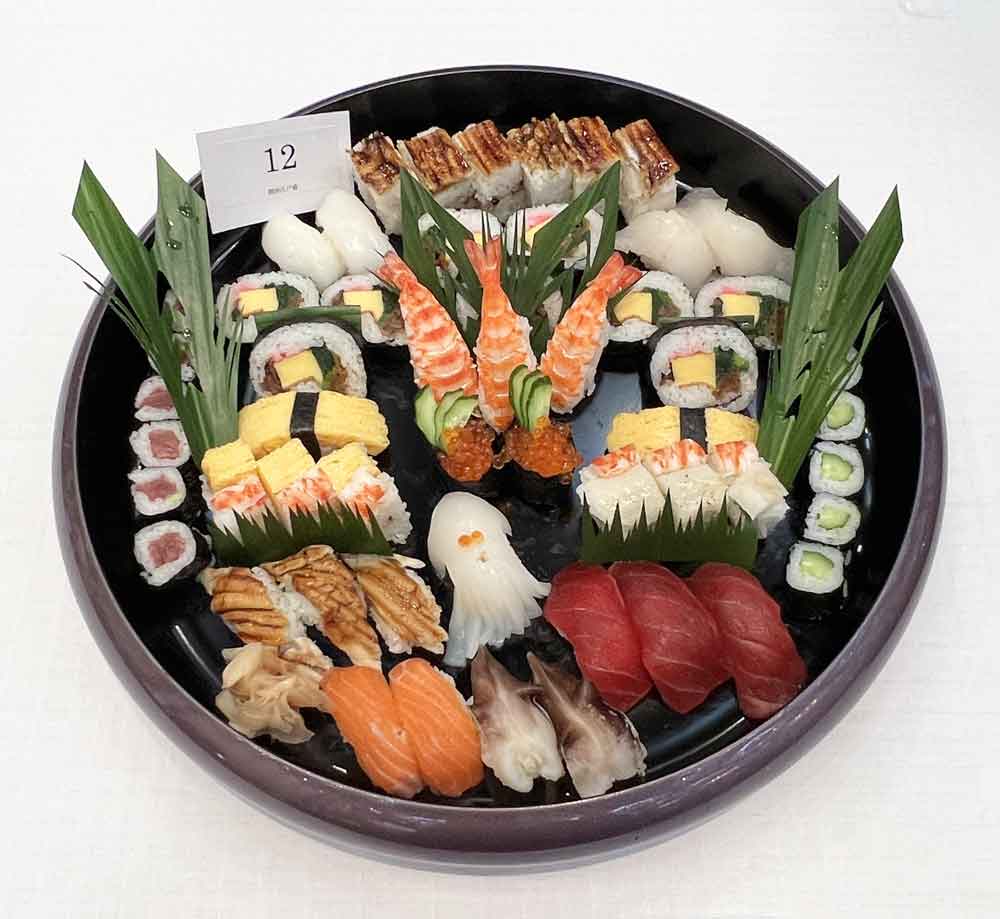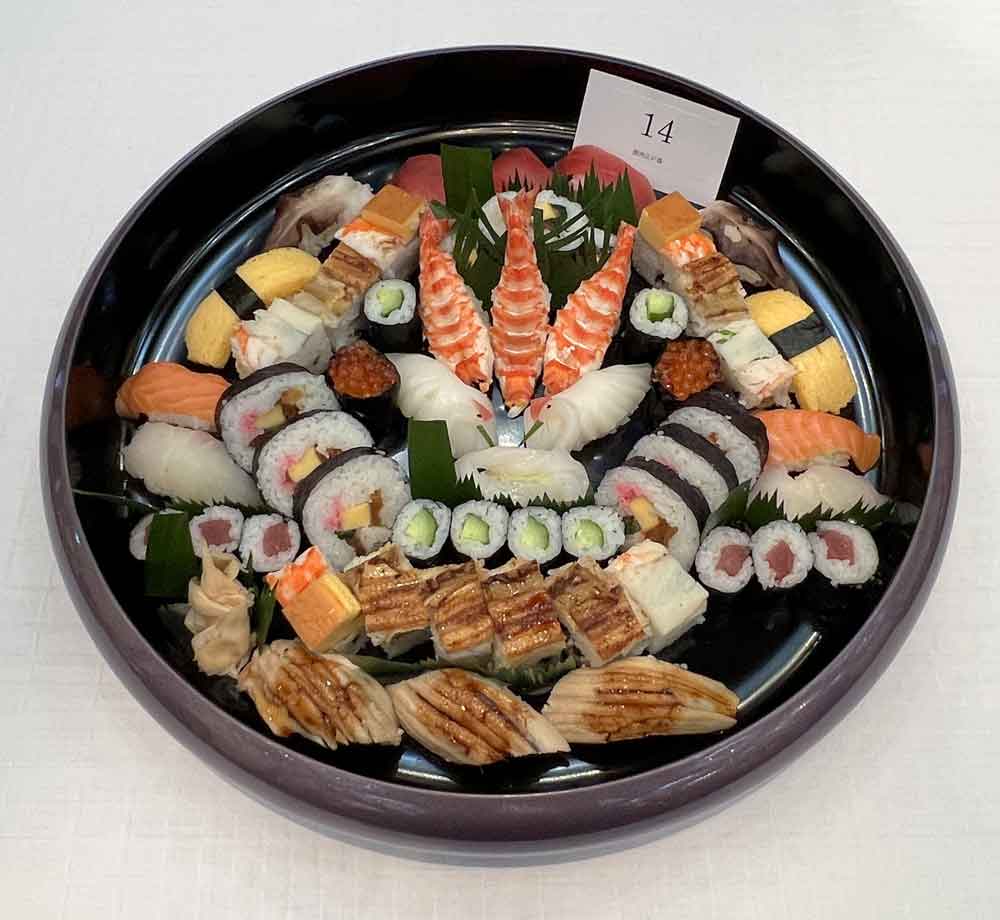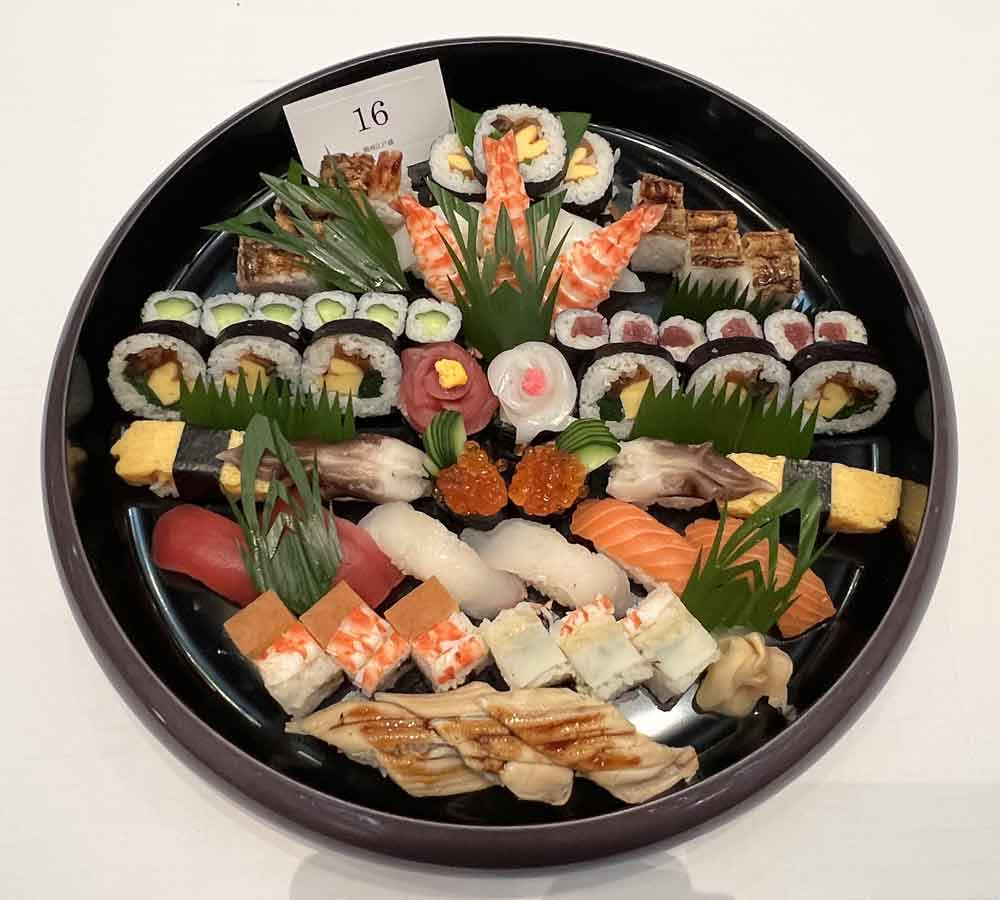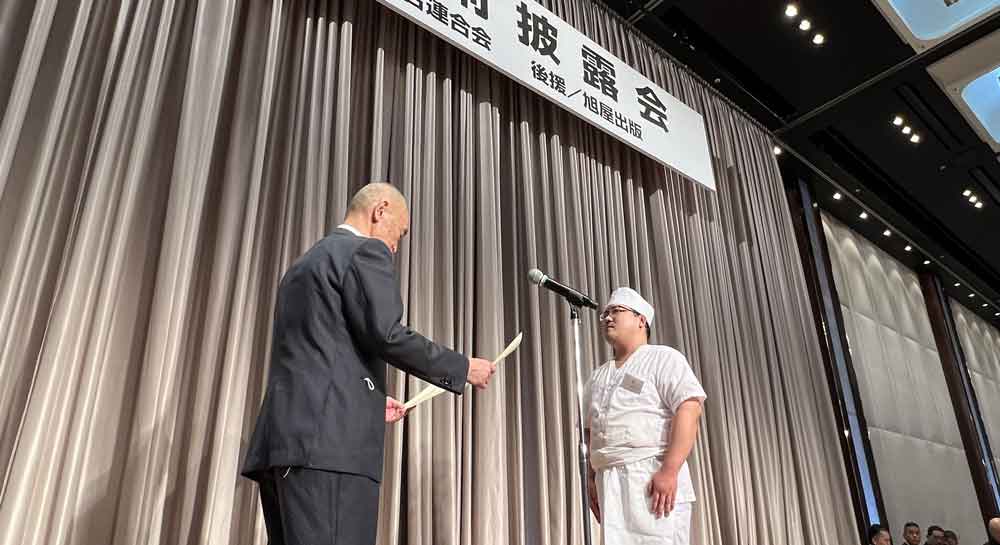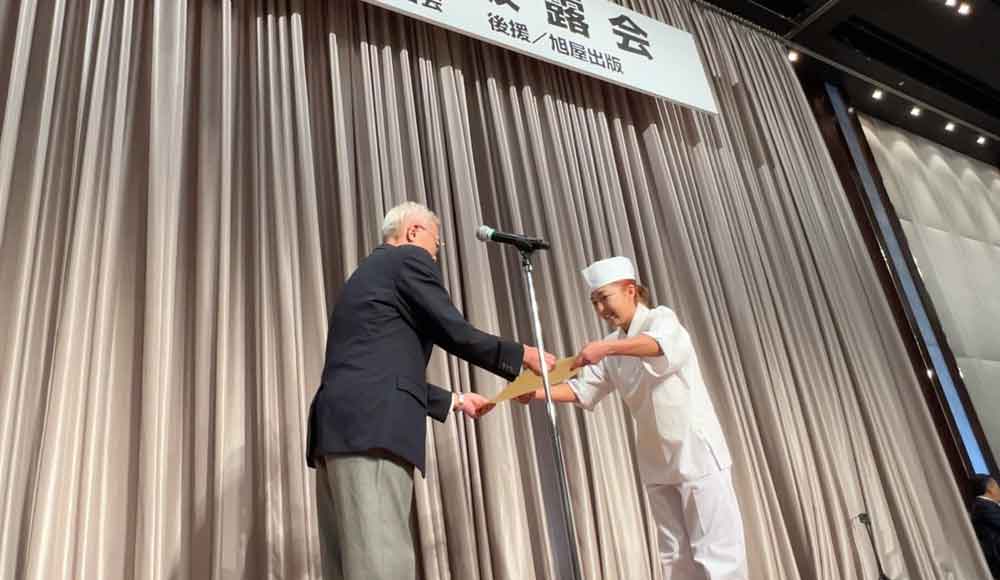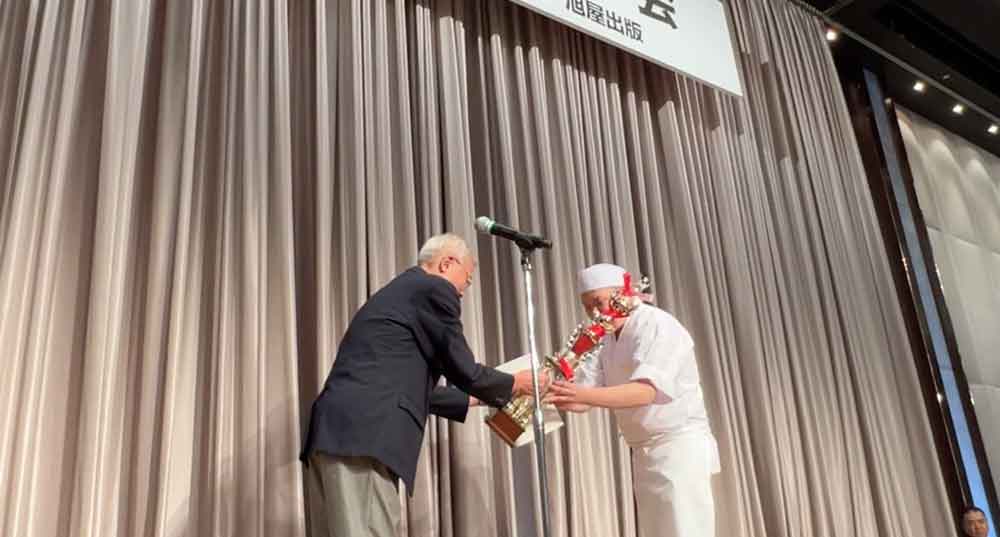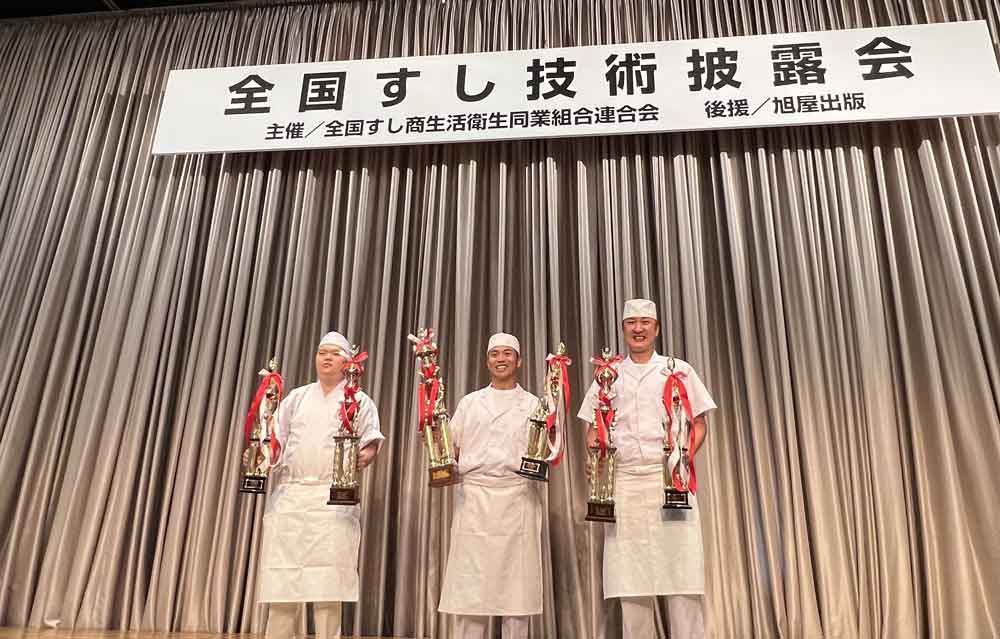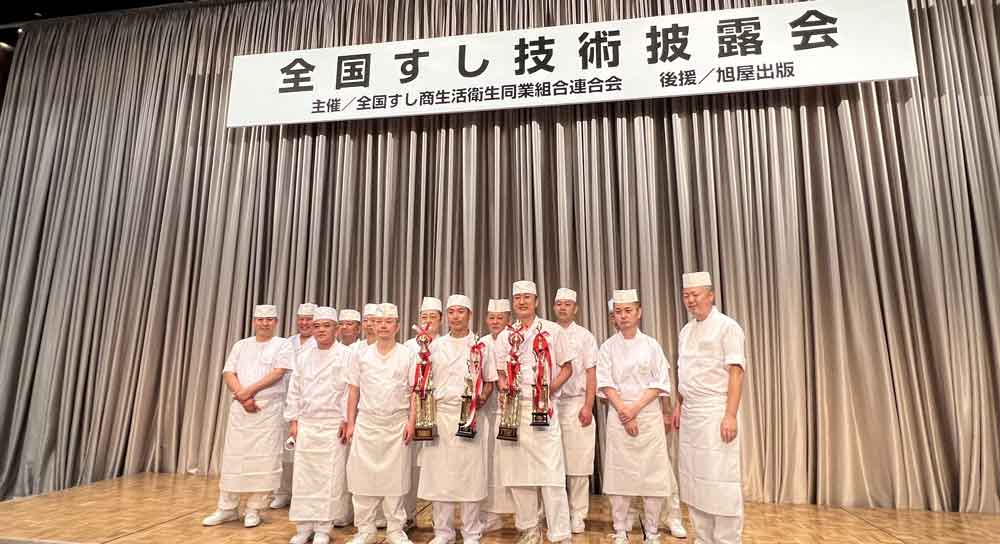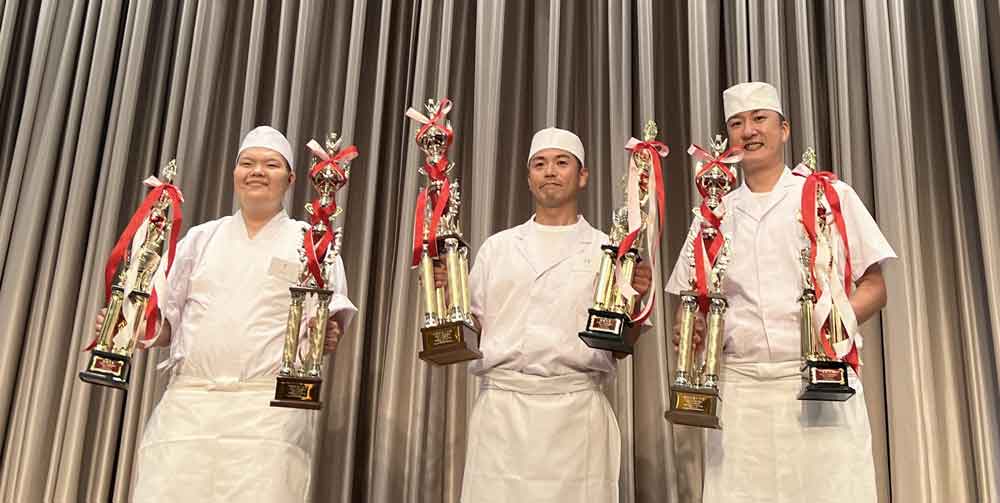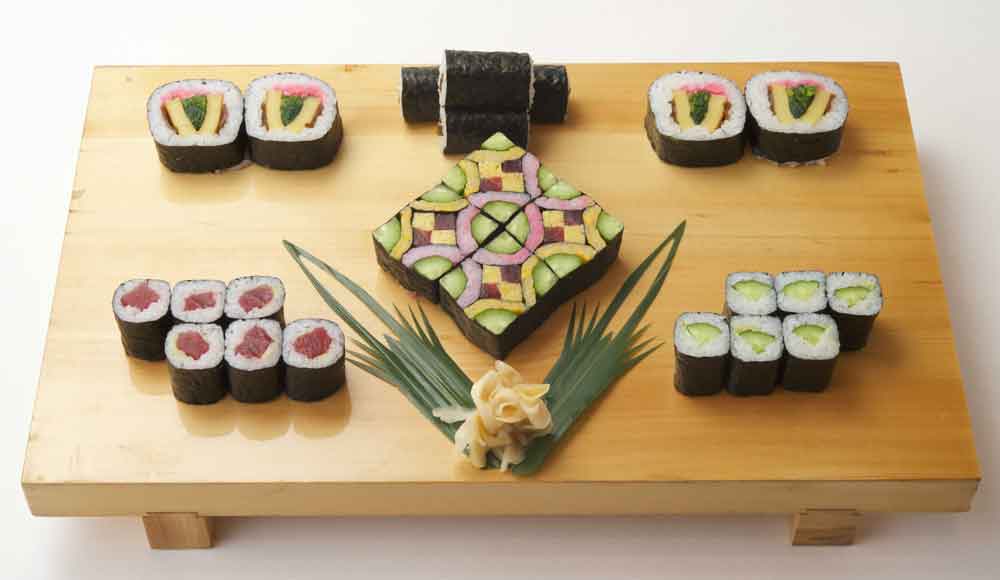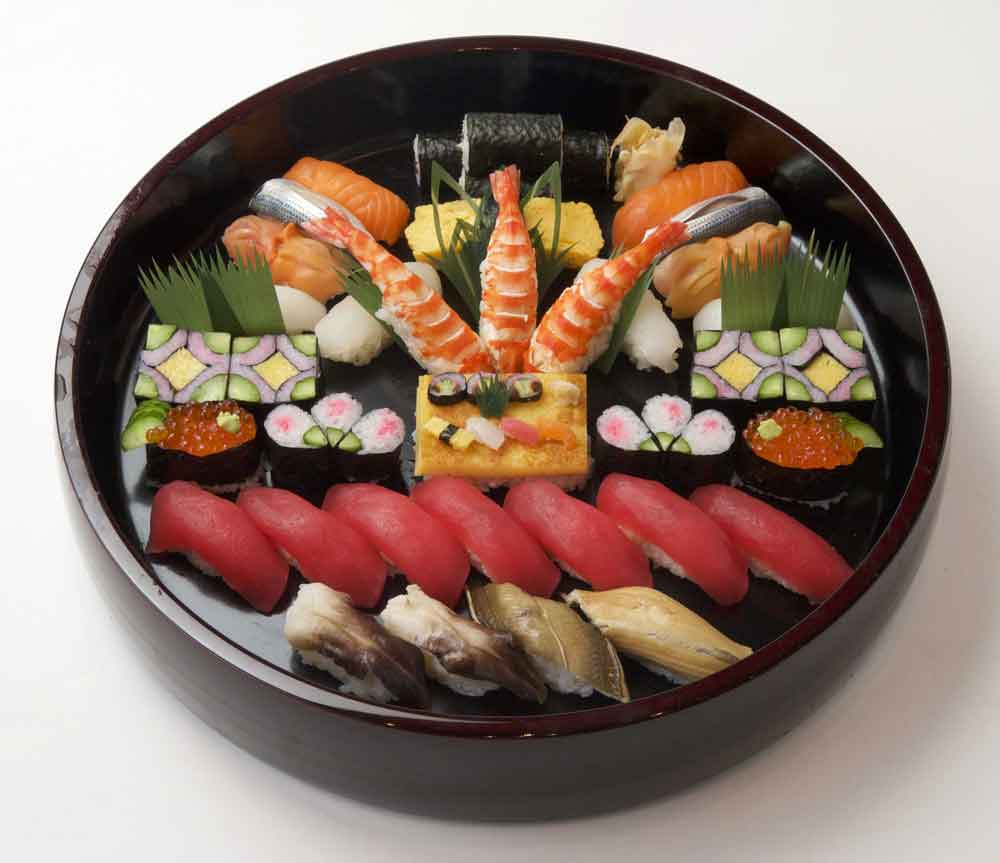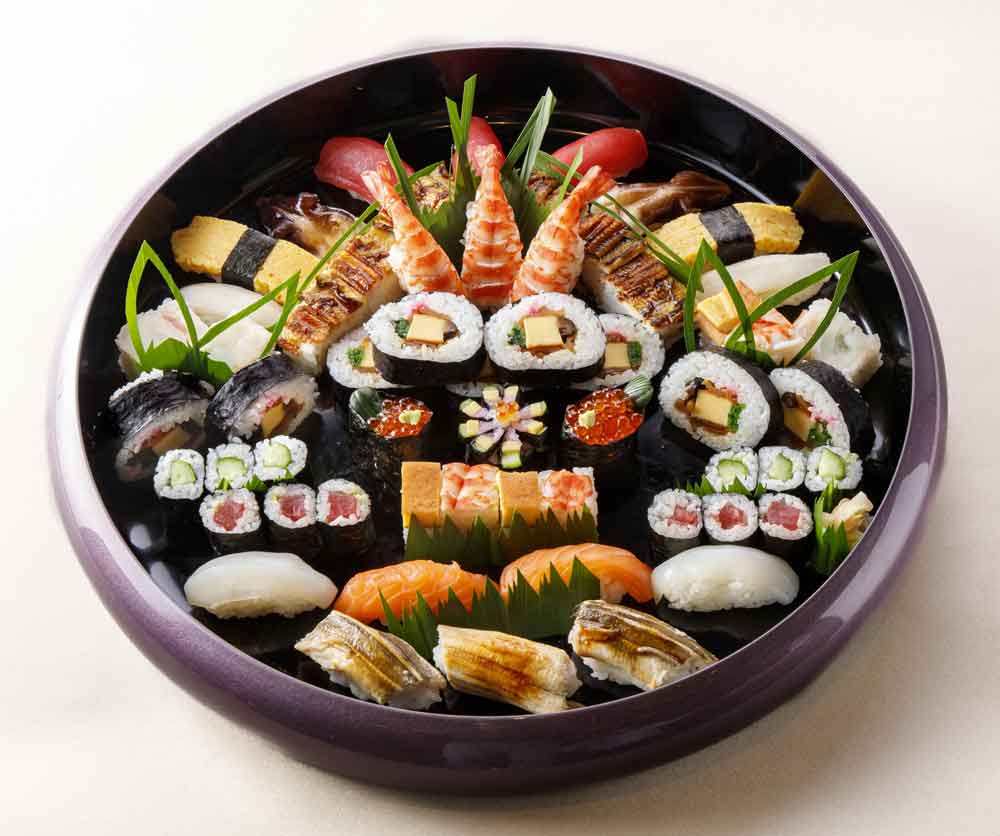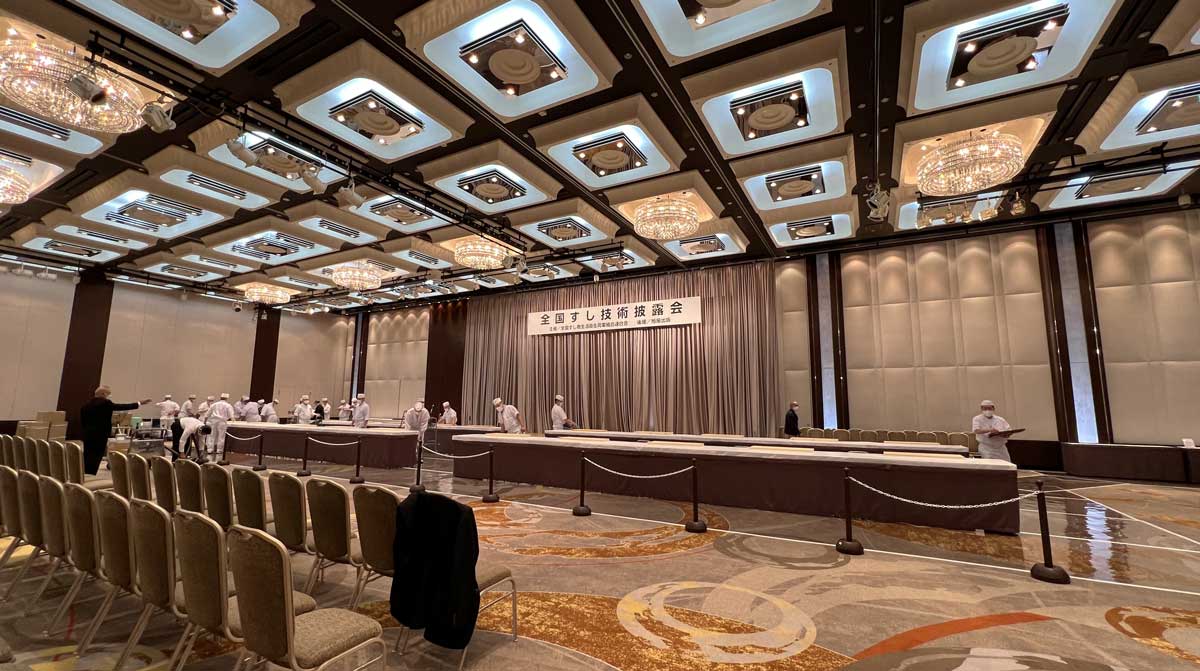
Venue: The Keio Plaza Hotel in Shinjuku
Opening Ceremony
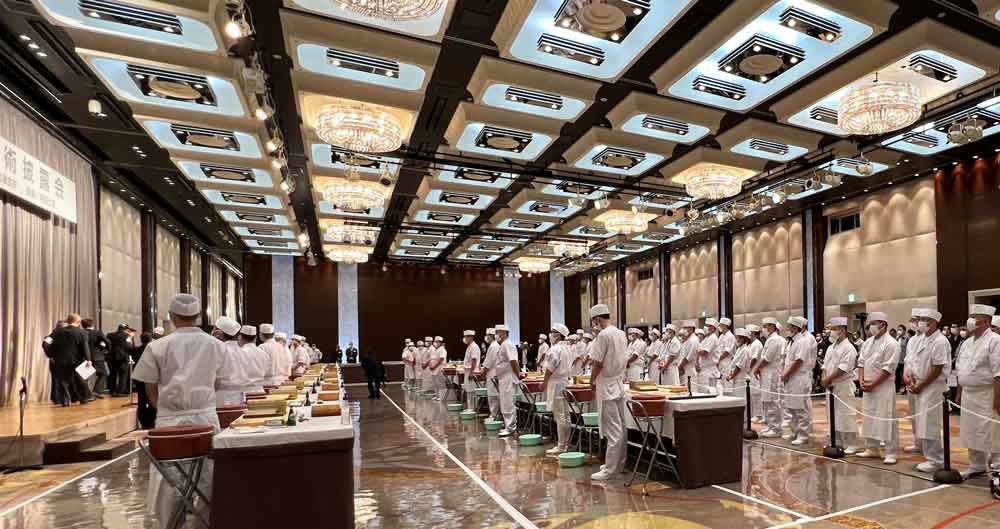
"I am delighted to announce the opening of the National Sushi Skills Contest."
 Akihiko Ogata
Akihiko Ogata
(Vice President, All Japan Sushi Association / Tokyo / Azuma-zushi)
On Tuesday, Oct 18, 2022, All Japan Sushi Association officials from across the country—together with many members of the general public—assembled at the Keio Plaza Hotel in Shinjuku, Tokyo for the National Sushi Skills Contest, organized by the All Japan Sushi Association, where 70 select sushi masters from across the country competed for top prizes. The event began with the opening declaration, quoted above, pronounced by the contest’s Executive Committee vice chairman Akihiko Ogata (Vice President, All Japan Sushi Association / Tokyo / Azuma-zushi).
Right after that, Executive Committee chairman Masanori Inoue (Vice President, All Japan Sushi Association / Osaka / Daiki) gave the opening greeting.
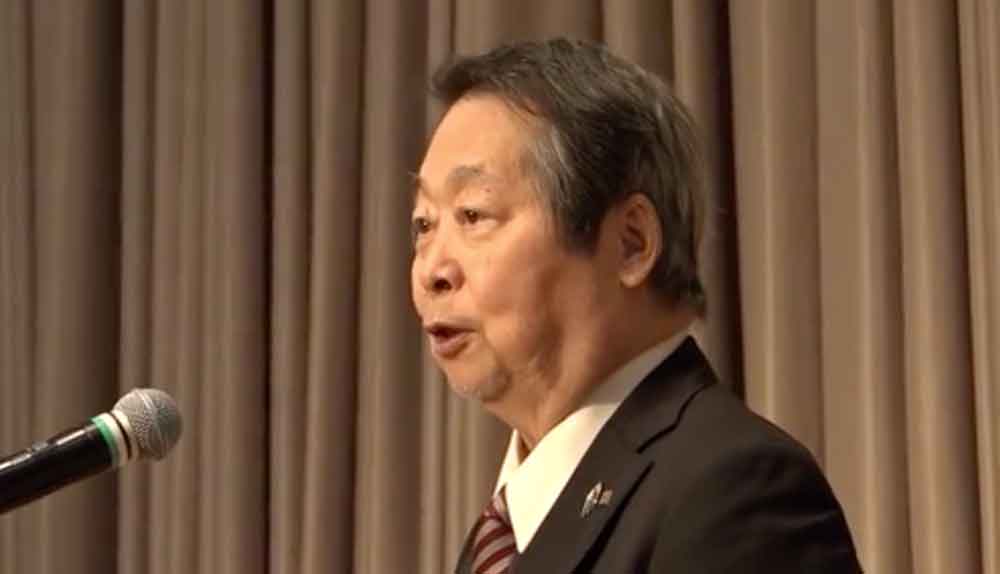 Masanori Inoue
Masanori Inoue
(Vice President, All Japan Sushi Association / Osaka / Daiki)
"In recent years, sushi has moved beyond our shores to achieve popularity in Europe, the US, and other countries. As a member of Japan’s sushi industry, I hope that today’s contest will showcase the great skills and deep training of our country’s sushi masters, in a way that can serve as a model for the entire world."
Next, contest chairman and executive committee member Tetsuya Asano (Chairman, All Japan Sushi Association) greeted the contestants.
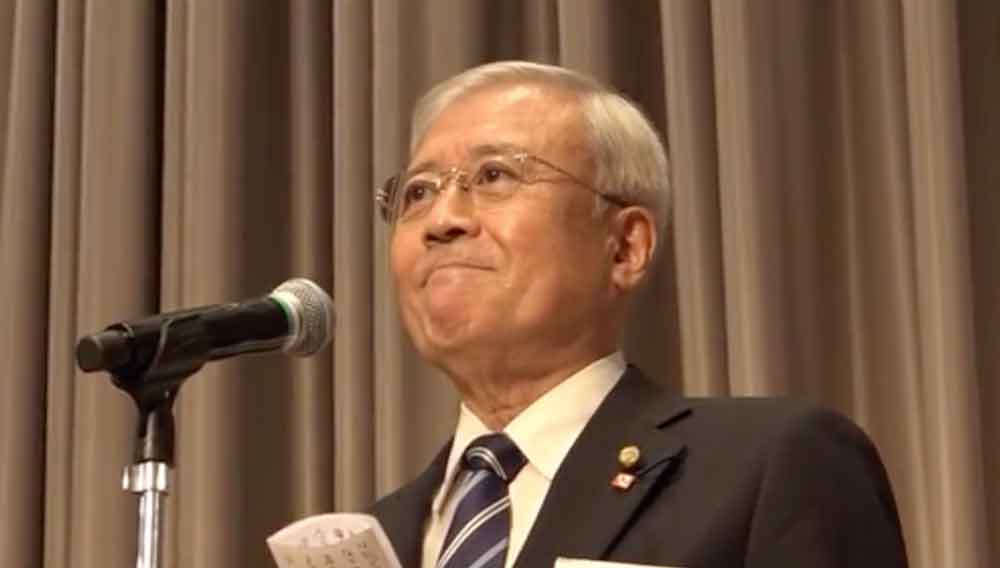 Tetsuya Asano
Tetsuya Asano
(Chairman, All Japan Sushi Association)
"In part because of the COVID epidemic, patrons today are tending to avoid longer mealtimes. In particular, many sushi establishments are still slow on weekday evenings, as customers continue to stay away. We hope that today’s event will showcase the daily discipline and efforts of sushi masters in a way that will earn greater public support. I’m confident that all of our contestants will do a great job demonstrating their wonderful talents."
Next, contest emcee Hideto Nakata (Managing Director, Tokyo Sushi Association / Kokubunji / Notozushi) introduced the 11-member Judging Committee. The opening ceremony then concluded with a greeting from the Committee Chair, Yasumasa Ōyama (Head of the Technical Committee of the All Japan Sushi Association / Kanagawa / Hamazushi).
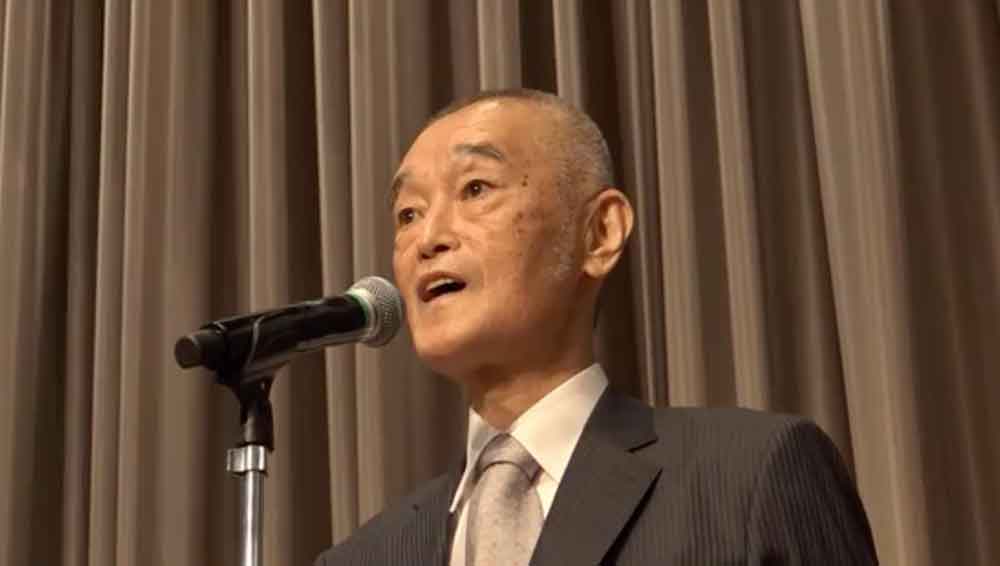 Yasumasa Ōyama
Yasumasa Ōyama
(Head of the Technical Committee of the All Japan Sushi Association / Kanagawa / Hamazushi)
"I know that all of our contestants have worked hard to prepare for today’s event, and we are anticipating a great display of skills and some wonderful creations. The ten members of the Judging Committee, and myself, are looking forward to doing our part. We urge all our contestants to do the same thing you do for your regular customers every day at your restaurant—that is, to create wonderful productions. But please be sure to finish up within the allotted time. Remember that you lose points if you do not finish within the time limit, and you also lose points if you don’t clean up. So please keep in mind that the clock is ticking."
Today’s Events
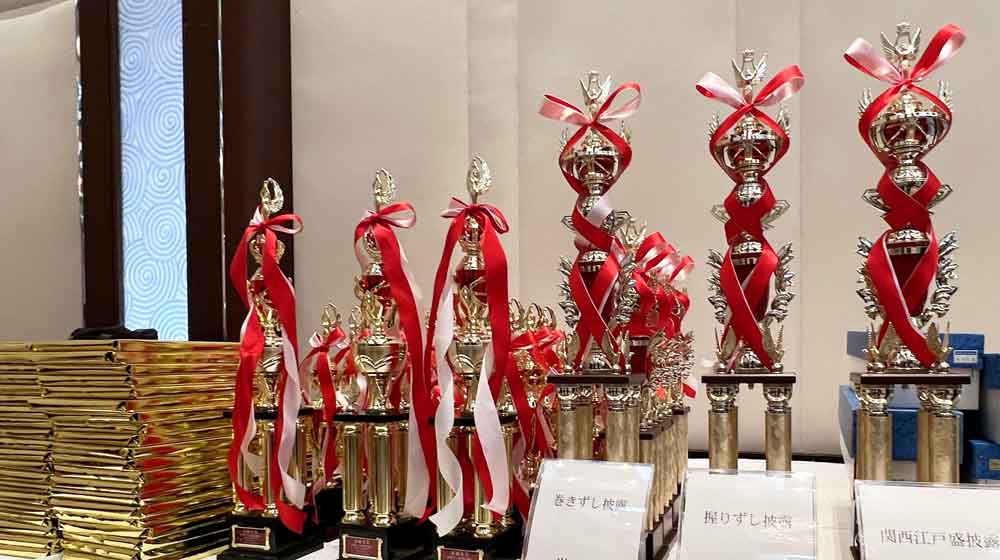
All contestants will apply their own skill, but they will all use the tools and ingredients provided to them. They are not permitted to bring in their own materials. There are three competition events.
| Today’s Events | contestants |
|---|---|
| Maki Zushi | 20 contestants |
| Nigiri Sushi (two sessions) | 34 contestants |
| Kansai-Edo Platter | 16 contestants |
| Way of working | 25 points |
|---|---|
| Completed creation | 70 points |
| Clean-up | 5 points |
| Total | 100 points |
Maki-Zushi Challenge
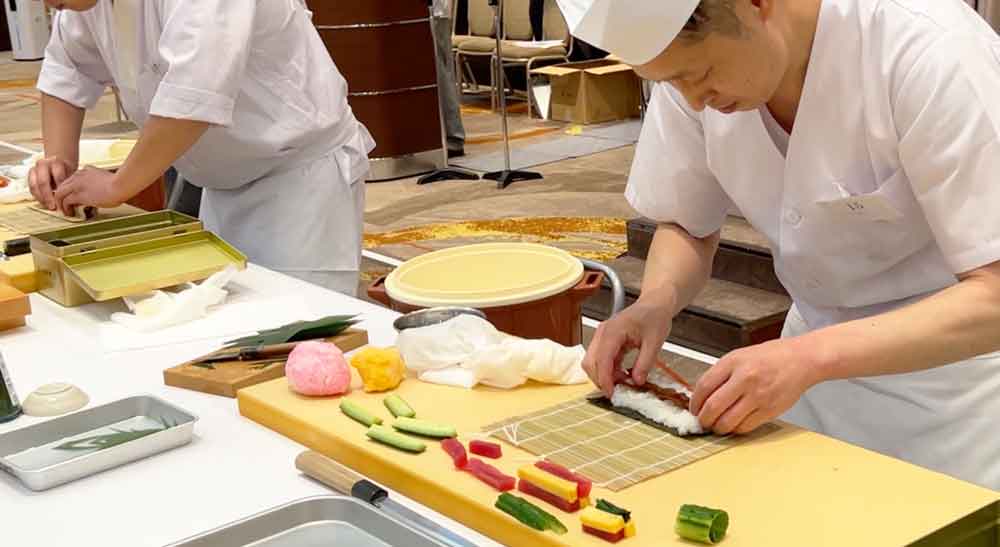
| Time Limit | 20 minutes. |
|---|---|
| The Challenge | Each contestant prepares five sushi rolls: one tekka roll, one kanpyo roll, one kappa roll, and two rolls of their own choosing. The contestant arranges these on a sushi-roll board, with a decoration of at least two freely carved bamboo leaves. |
The 20 contestants completed this challenge.
They each begin by carving the bamboo leaves. Both bamboo and haran leaves possess bacteria-killing properties, and were originally used to help keep sushi fresh. Today, however, sushi masters use these leaves to showcase their carving techniques, and to partition and decorate the sushi being served.
In recent years, the ingenuity of sushi chefs has brought forth many imaginative designs and techniques that play an important supporting role in the sushi experience. The carving and arrangement showcase an important part of the sushi master’s skills.
To create a good sushi roll, the chef must spread the bed of rice quickly and carefully and place the main ingredient so that it will be correctly centered when rolled. The pressure to the rolling mat must be skillfully applied, and the final rolls must be cleanly cut and equal in length, with no scratches or rice smudges on the surrounding nori. These techniques greatly affect the appearance and taste experience of the completed sushi rolls.
The balance at both ends, and the colors, are other indications of the chef’s artistic sense. Contestants must be delicate, precise, and careful as they complete this work in the limited time allowed.
Nigiri-Zushi Challenge
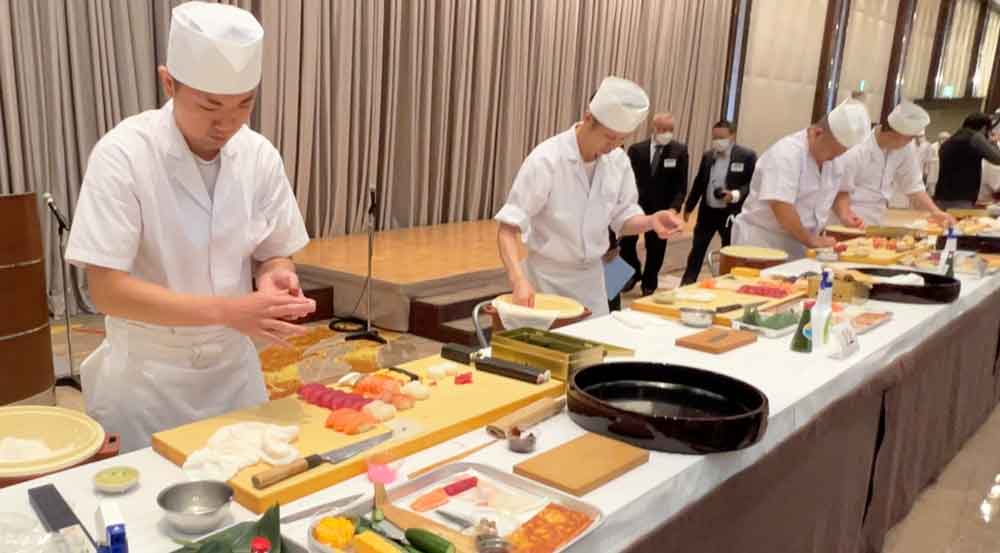
| Time Limit | 35 minutes |
|---|---|
| The Challenge | Create a sushi board for five persons. The composition—including the number of nigiri pieces and sushi rolls, the leaf decorations, and the techniques employed—is entirely at the discretion of the chef. The scoring takes into account the arrangement and the cleanup. |
The challenge was presented in two sessions, with a total of 34 contestants.
New bamboo leaves, which appear in June, are soft, bright green, and easy to cut. When working with new leaves, the chef can stack eight or ten leaves and cut them all at once. At other times of the year the leaves are tougher, but can be softened for cutting by soaking in hot water.
Judges are looking for quick carving work and beautiful results. The bamboo leaf typically used for sushi is called kumazasa. The chef may cut multiple leaves at once when preparing the partitioning pieces (the kenzasa and sekisho), but carve leaves one a time when fashioning the decorative pieces.
When folding the leaves before cutting, the chef must hold these in place with the non-dominant hand, using four fingers to gauge the lengths. This technique makes it possible to cut even large leaves into equally sized lengths and widths.
The knife work when carving these leaves is a core skill of the sushi chef. The carved leaves tend to wilt rather quickly, so they also play a role as an indicator of freshness. To ensure the best taste, eat your sushi while the leaves are still fresh.
Our contestants may find it unusually challenging to demonstrate their skills in the unfamiliar setting of today’s venue. Unlike the cutting boards they are used to working with, these boards are standard, and the cuttability of the neta (ingredients) may also differ from what they expect. Contestants will have to work carefully, taking into account these differences.
Posture, speed, and accuracy are very important when judging how contestants hold and shape the sushi pieces. When looking at the finished plate, judges pay close attention to the arrangement of angles and colors, and the placement of the leaves. There should also be about one finger length of clear, clean space between the sushi and the edge of the platter. The professional sushi chef must create sushi arrangements that look inviting and delicious.
Kansai-Edo Platter Challenge
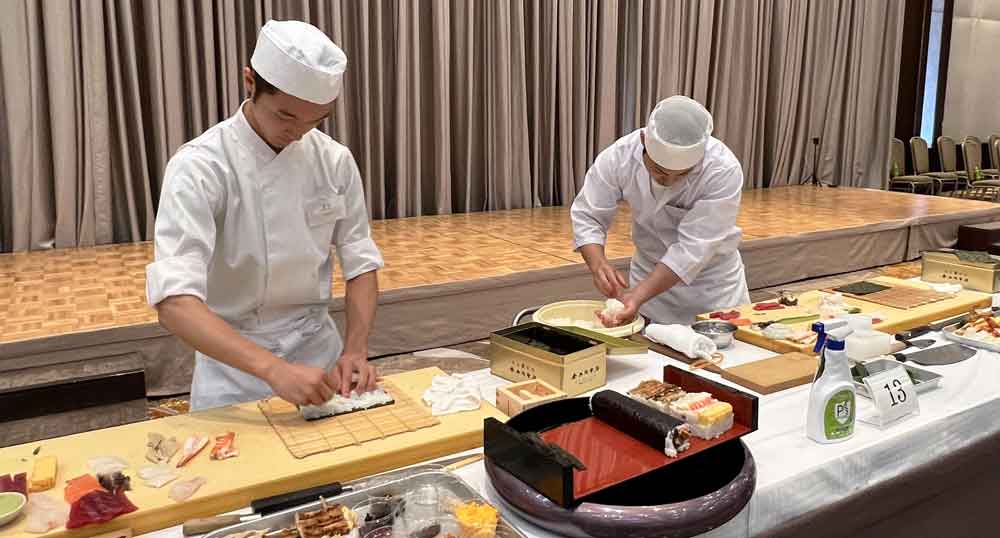
| Time Limit | 40 minutes |
|---|---|
| The Challenge | The chef has full freedom in selecting and designing haran leaves such as, shrimp shapes, pine shapes, sekisho, and other components. The chef is required to create all of the following; one nakamaki, one cucumber maki, one tekka roll, one kera-bako (hako-zushi), one piece of grilled conger eel, and 23 pieces of sushi (3 squid, 3 tuna, 3 sea bream, 3 shrimp, 2 egg, 2 salmon roe, 2 cockle, 2 salmon, and 3 conger eel), all arranged in a wooden sushi bowl. |
Sixteen contestants participated in this part of the competition.
Kansai-Edo platters are often part of the competitions conducted in the Kinki district, an area that includes Osaka, Kyoto, Shiga, and Hyōgo. Today’s event marks the first time these platters are included in a national competition.
The sushi part of the platter shall be a combination of nigiri, futomaki (thick roll), hosomaki (thin roll), hako-zushi (boxed sushi), and saiku-zushi (decorative sushi). The hako-zushi may be unfamiliar to people from outside of Kinki, but core requirements for all Kansai sushi masters skills are not only in nigiri and maki (rolls), but also in hako-zushi.
Keep in mind that the creations here are just the final stage of a long process. While our contestants are capable of squeezing out a nigiri or rolling out a making in a matter of moments, this is only because they have spent prodigious time and effort in developing their skills. The is especially true in the preparation of hako-zushi.
The hako-zushi for this contest is a combination of pressed box items as follows: conger eel and a kera-bako, which is mixed with thick fried egg, shrimp, and whitefish. Dried shiitake mushroom, steamed in a sweet-sour broth and then minced, is set into the boxed part for both items, as an additional treat (nakagu).
In addition to the preparation of hako-zushi, creation of nigiri-sushi differs between Kansai Edo Platter and Nigiri Sushi challenges. For example, where the former uses bamboo leaf and back-sliced conger eel, the latter uses haran leaves and front slicing.
Unfortunately, fewer and fewer chefs are offering hako-zushi, even in Kansai. Our contestants represent the small group of professionals still capable of producing this specialty.
Awards Ceremony
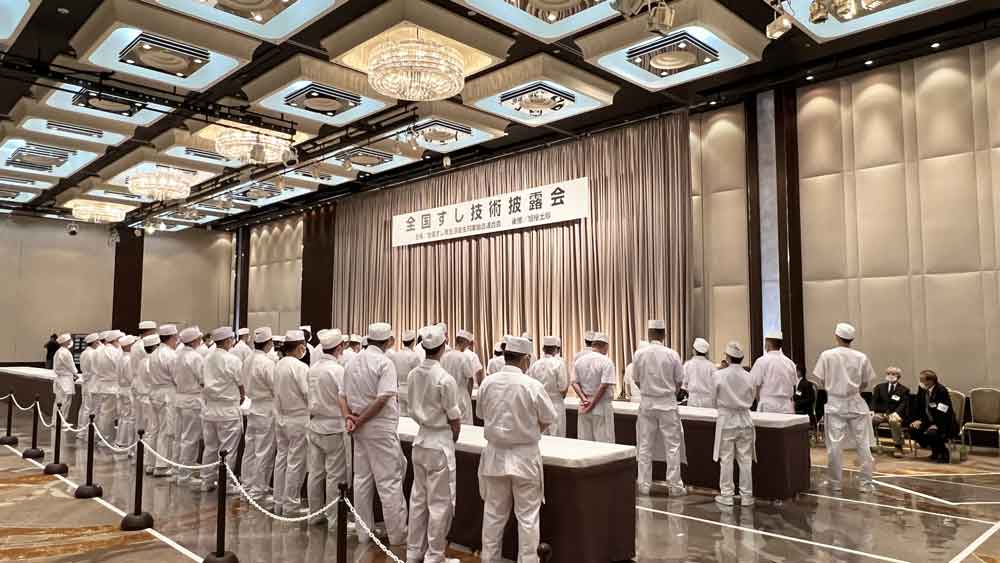
All 70 contestants attended the awards ceremony. Judging Committee Chair, Yasumasa Ōyama announced the results and presented the awards. Mr. Ōyama and chief judge Mr. Aoyama then made some general comments, and Mr. Aoyama gave a closing address, bringing the contest to an end.
Wonderful Sushi For Everyone…
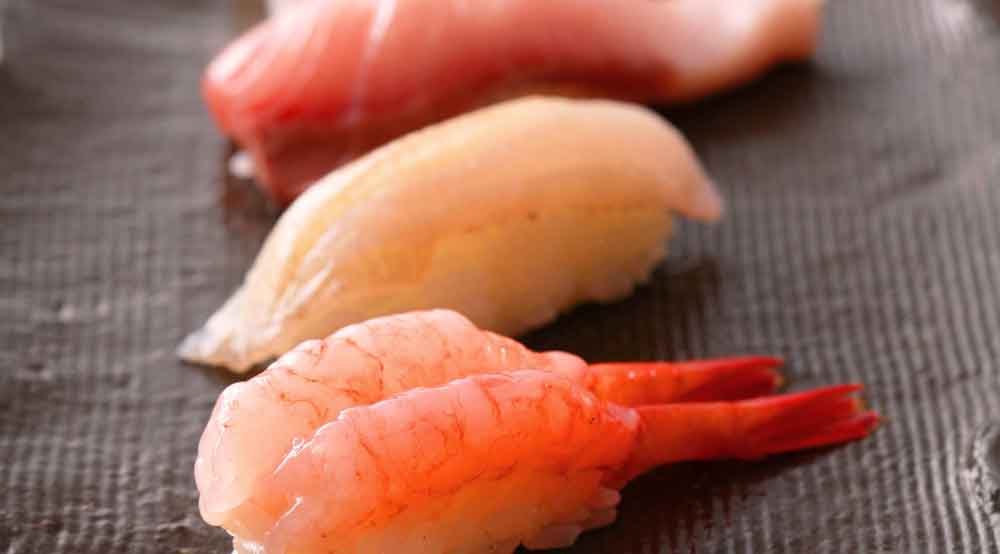
Sushi chefs are constantly working to further develop the skills that enable them to create sushi joy to their patrons. Our contestants were fortunate to participate in this challenging event where they had the opportunity to display the best of their skills to a fascinated audience—an experience that will serve them well as they continue to develop their craft.
A true professional quickly conquers the challenges presented. The pro makes it look so easy that everyone who watches thinks they might be able to do the same thing—until they give it a try, and see that they can’t. The pro gets the job done with great skill and care, within very limited time.
A well-known saying in the sushi industry is that it takes three years to learn to cook the rice correctly, then five more years to learn to how to mix in the vinegar, and a lifetime to learn to make the sushi. The general consensus is that it takes ten years to become a pro: the first three years as a beginner, and then seven years of development.
But while sushi is a great Japanese tradition, there are no official licenses or qualifications to tell us who the real pros are. The aspiring pro is truly free and independent. Anyone with the necessary capital can open a sushi restaurant and start serving something—but keeping the enterprise going is an entirely different matter. It’s the same in most businesses—it’s easy enough to get in, but very challenging to achieve a lasting success.
"Yet, as another saying has it: Perseverance builds strength."
We are confident that our contestants performed at or close to the very peak of the abilities they have developed over long training and experience. And we also hope that, starting tomorrow, they resume their efforts to further develop their art, aiming for higher peaks in the years ahead. Study and effort continue for a lifetime.
Contest Emcee Mr. Hideto Nakaka (Managing Director, Tokyo Sushi Association / Tokyo / Notozushi)
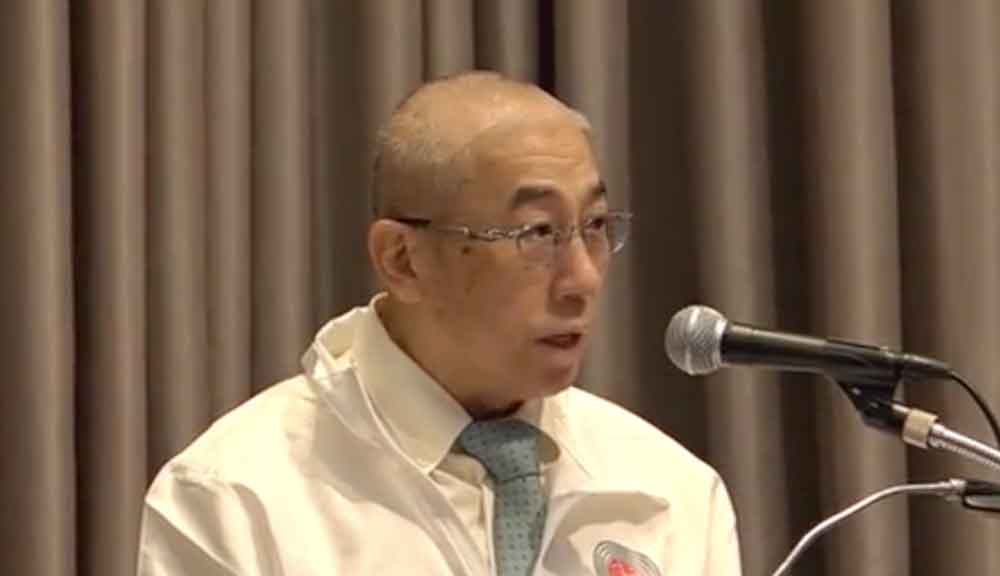 中田 秀人 東京都すし組合 常務理事(東京都/能登寿司)
中田 秀人 東京都すし組合 常務理事(東京都/能登寿司)
Remember that sushi masters throughout the country, just like our contestants at this event, are every day honing their skills in their efforts to present their patrons with wonderful cuisine. We encourage everyone to visit your local sushi restaurants and enjoy the creations of your local sushi masters.
Judging Committee
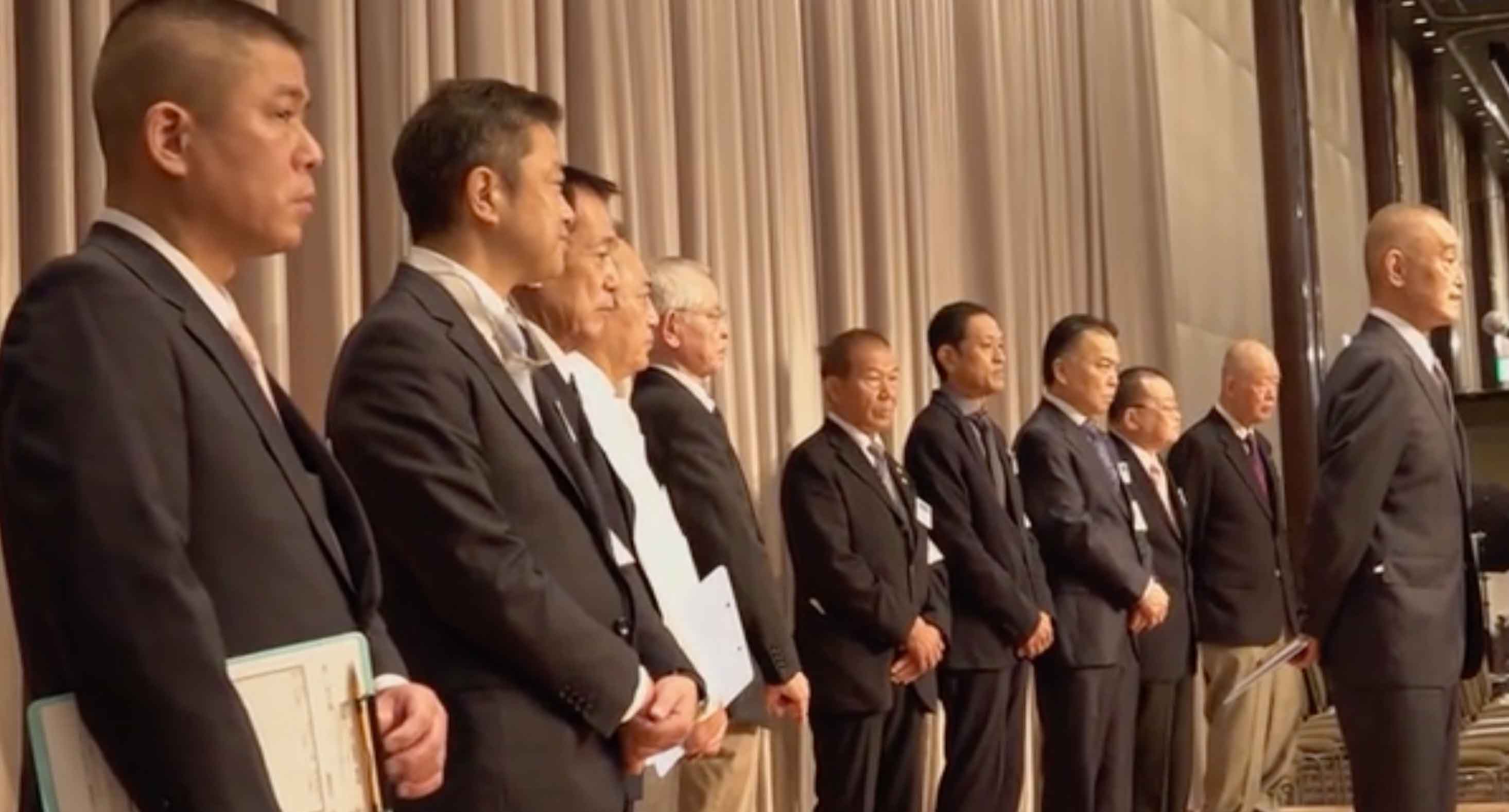
| Judging Committee Chair | |
|---|---|
| Yasumasa Ōyama | Head of Technical Committee of the All Japan Sushi Association (Kanagawa / Hama Zushi) |
| Judging Committee Members | |
| Akira Saitō | Hokkaido District (Hokkaido / Sushiya no Saitō) |
| Hidetoshi Satō | Tōhoku District (Yamagata / Sushi Kappō Suzumasa) |
| Hiroshi Inou | Kantō Kōshin’etsu District (Saitama / Hana Sushi) |
| Hidenobu Meguro | Tokyo District (Tokyo / Yoroshiku Sushi) |
| Yoshinobu Ozaki | Chūbu District (Shizuoka / Sushi-Dokoro Ozaki) |
| Shūji Aoyama | Kinki District (Shiga / Maruman) |
| Isami Kawanaka | Chūgoku-Shikoku District (Ehime / Isami-zushi Hokusai) |
| Kenji Matsunobu | Kyūshū District (Kagoshima / Yasuke) |
| Masayoshi Kazato | President, World Sushi Skills Institute (Chiba / Sakae-zushi) |
| Hiruaki Yamazaki | Former Head, Technical Committee, All Japan Sushi Association (Tokyo / Janome Sushi) |
| Chairman | |
|---|---|
| Masanori Inoue | Vice President, All Japan Sushi Association (Osaka / Daiki) |
| Vice Chair | |
| Akihiko Ogata | Vice President, All Japan Sushi Association (Tokyo / Azuma-Zushi) |
| Vice Chair, member Judging Committee | |
| Hiruaki Yamazaki | Former Head, Technical Committee, All Japan Sushi Association (Tokyo / Janome Sushi) |
| member Judging Committee | |
| Kazuhisa Kadoguchi | Assistant Chair, Osaka Sushi Association (Osaka / Tsuribune Iwashi-tei) |
| Tomotsugu Naruo | Assistant Chair, Osaka Sushi Association (Osaka / Sushi-Kappō Naruo) |
| Atsushi Wakatake | Managing Director, All Japan Sushi Association |
| Contest Chair | |
| Tetsuya Asano | Chair, All Japan Sushi Association |
National Sushi Skills Contest
When: Tuesday October 18, 2022, 10:15 AM to 3:30 PM
Venue: The Keio Plaza Hotel in Shinjuku
Organize By: All Japan Sushi Association
Supported by: Asahiya Publishing Co., Ltd.


